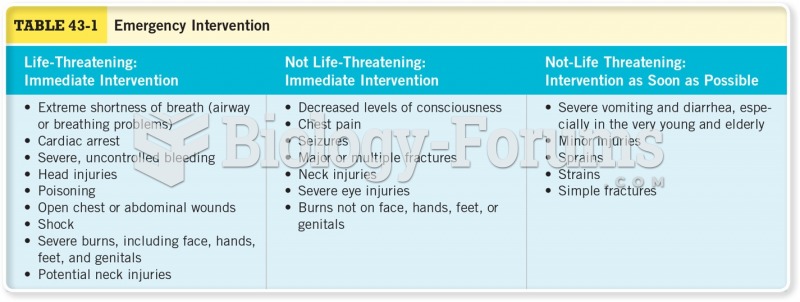Answer to Question 1
Stabilize respiratory function. Take oximeter reading on room air; if the Spo
2is low, deliver O
2
by
nasal cannula; titrate upward until Spo
2
is over 90.
Stabilize cardiac function. Get an ECG; draw samples for creatinine phosphokinase (CK) and
troponin levels.
Monitor mental capacity and level of consciousness.
Draw samples for laboratory tests: CBC; chemistry panel to assess glucose, electrolytes, and
thyroid-stimulating hormone (TSH) to check for thyroid disorder; D-dimer to check for pulmonary
embolism.
Answer to Question 2
Answers: a, d, e, g
Naltrexone, acamprosate, and disulfiram are used once the acute stage of alcohol withdrawal
delirium has subsided. The naltrexone helps reduce alcohol craving. The acamprosate and disulfiram
both work to help with adherence to abstinence from alcohol.
Benzodiazepines, such as chlordiazepoxide (Librium), help reduce withdrawal symptoms, stabilize
VS, and prevent seizures.
Clonidine (Catapres), an alpha-adrenergic blocker, is given to reduce the symptoms of autonomic
withdrawal.
Antiepileptic drugs (carbamazepine Tegretol) are given to prevent the seizures that often occur
with withdrawal.
Beta-adrenergic blockers (atenolol Tenormin) help stabilize VS, decrease craving, and reduce the
symptoms of autonomic withdrawal.
GI:Acute gastritis, pancreatitis, hepatitis, cirrhosis of the liver, esophageal varices, hemorrhoids,
ascites, vitamin B deficiencies (specifically thiamine, B12 , and folic acid)
Cardiovascular:portal hypertension, heart failure
Respiratory:susceptibility to pneumonia and other respiratory tract infections as a result of
respiratory depression and depressed cough reflex
Neurologic:central nervous system depression, peripheral neuropathy, interference with nerve
conduction, Wernicke encephalopathy (an inflammatory, hemorrhagic, degenerative condition of
the brain caused by thiamine deficiency), and Korsakoff psychosis (form of amnesia; inability to
learn new skills; disorientation)
Reproductive system:prostatitis
Fetus during pregnancy:fetal alcohol syndrome and other congenital defects
Nutritional problems:poor general nutrition; deficiencies in vitamins, particularly A, B, D, and K
(increasing bruising and bleeding tendency); deficiencies in magnesium and potassium levels
(might cause delirium, cardiac dysrhythmias, seizures); anemia and decreased white blood cells
(might cause an increased susceptibility to infection)
Complete blood count; chemistry panel with prealbumin; lipid profile; thiamine, folate, B 12, iron, magnesium levels; urinalysis; and hepatitis screen
 The nitrogen cycle. Numbers represent fluxes as 1012 g N per year (data from Schlesinger 1991, after
The nitrogen cycle. Numbers represent fluxes as 1012 g N per year (data from Schlesinger 1991, after
 Reindeer antlers grow again each year under a layer of fur called velvet. This reindeer is losing th
Reindeer antlers grow again each year under a layer of fur called velvet. This reindeer is losing th





